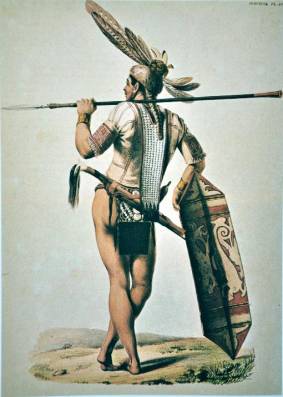Ngaju people
You can help expand this article with text translated from the corresponding article in Indonesian. (November 2014) Click [show] for important translation instructions.
|
 An illustration of a Dayak Ngaju warrior. | |
| Total population | |
|---|---|
| 400,000 | |
| Regions with significant populations | |
| Central Kalimantan | 324,504 (2000)[1] |
| Languages | |
| Ngaju language, Bakumpai language, Indonesian language | |
| Religion | |
| Christianity (Protestant Christian & Catholicism) 44%, Islam (Sunni) 43%, Kaharingan 13% [2] | |
| Related ethnic groups | |
| Dayak people (Bakumpai people, Meratus Dayak) | |
The Ngaju people (also Ngaju Dayak or Dayak Ngaju or Biaju) are an indigenous ethnic group of Borneo from the Dayak group.[3] In a census from 2000, when they were first listed as a separate ethnic group, they made up 18.02% of the population of Central Kalimantan province. In an earlier census from 1930, the Ngaju people were included in the Dayak people count.[4] They speak the Ngaju language.
Subgroups

Based on river stream regions, the Ngaju people are divided into:-
- Greater Batang Baiju - Greater Baiju River
- Lesser Batang Baiju - Lesser Baiju River
Based on language, the Ngaju people are divided into:
- Dayak Ngaju (Ngaju Kapuas)
- Dayak Kahayan (Ngaju Kahayan)
- Dayak Katingan (Ngaju Katingan)
- Dayak Mendawai (Central Kalimantan)
- Dayak Bakumpai (South Kalimantan)
- Dayak Meratus (South Kalimantan)
- Dayak Mengkatip (Central Kalimantan)
- Dayak Berangas (South Kalimantan, which is said to be no longer identifiable and their language is no longer in existence as of 2010 due to assimilation into the mainstream Kuala Banjar people)
- Dayak Beraki (Bara-ki; no longer in existence)[5]
Culture
Traditional folk songs
- Sinta Takalupe Lunuk[6]
- Karungut, Kal-Teng Membangun[7]
- Yang Mahakasih (religious song)[8]
Food
- Kopu, fermented cassava root. Usually eaten by mixing with shredded coconut meat[9][10]
- Karuang or Kalumpe by the Ma'anyan people, a pounded Cassava leaf salad mixed with eggplant, lemongrass, onion and garlic.[10]
- Juhu Umbut Batang Undus, coconut sprout salad eaten with sambal and often served during thanksgiving or wedding ceremonies.[10]
Notable Dayak Ngaju people
- Hausman Baboe, a prominent figure in the Central Kalimantan press and founder of the first daily Suara Dayak Indonesian newspaper.
- Tjilik Riwut, a National Hero of Indonesia, founder of Central Kalimantan, a writer, a Central Kalimantan freedom fighter and former governor of Central Kalimantan.
See also
References
- ^ Badan Pusat Statistik - Sensus Penduduk Tahun 2000
- ^ Chalmers, Ian (2006). "The Dynamics of Conversion: The Islamisation of the Dayak Peoples of Central Kalimantan". In Vickers, A.; Hanlon, M. (eds.). Proceedings of the 16th Biennial Conference of the Asian Studies Association of Australia (ASAA): Asia Reconstructed, Jun 26–29 2006. Wollongong, NSW: Australian National University. hdl:20.500.11937/35283.
- ^ Leo Suryadinata, Evi Nurvidya Arifin & Aris Ananta (2003). Indonesia's Population: Ethnicity and Religion in a Changing Political Landscape. Institute of Southeast Asian Studies. ISBN 981-230-212-3.
- ^ Riwanto Tirtosudarmo (2007). Mencari Indonesia: Demografi-Politik Pasca-Soeharto. Yayasan Obor Indonesia. ISBN 978-979-799-083-1.
- ^ M. J. Melalatoa (1995). Ensiklopedi Suku Bangsa Di Indonesia, Volume 1. Departemen Pendidikan dan Kebudayaan RI. OCLC 37396203.
- ^ "lagu dayak Erika sinta takalupe lunuk". Rocky wans. Retrieved 2015-08-05.[dead YouTube link]
- ^ "Karungut Kal-Teng Membangun (karungut modern)". tingang. Retrieved 2015-08-05.[dead YouTube link]
- ^ Pak Siswa 2 Ktsp-revisi (tuhan Mengasihi Semua Orang). BPK Gunung Mulia. 2007. ISBN 978-979-687-591-7.
- ^ Iwan Prasetya (22 June 2013). "Nikmatnya Daging Paing, Kelelawar Raksasa Khas Kalteng". Liputan6. Archived from the original on November 5, 2016. Retrieved 2016-11-05.
{{cite web}}: CS1 maint: unfit URL (link) - ^ a b c Febria Silaen (20 May 2016). "Sederet kuliner khas Kalimantan Tengah". Beritagar. Retrieved 2016-11-05.
Wikimedia Commons has media related to Ngaju people.